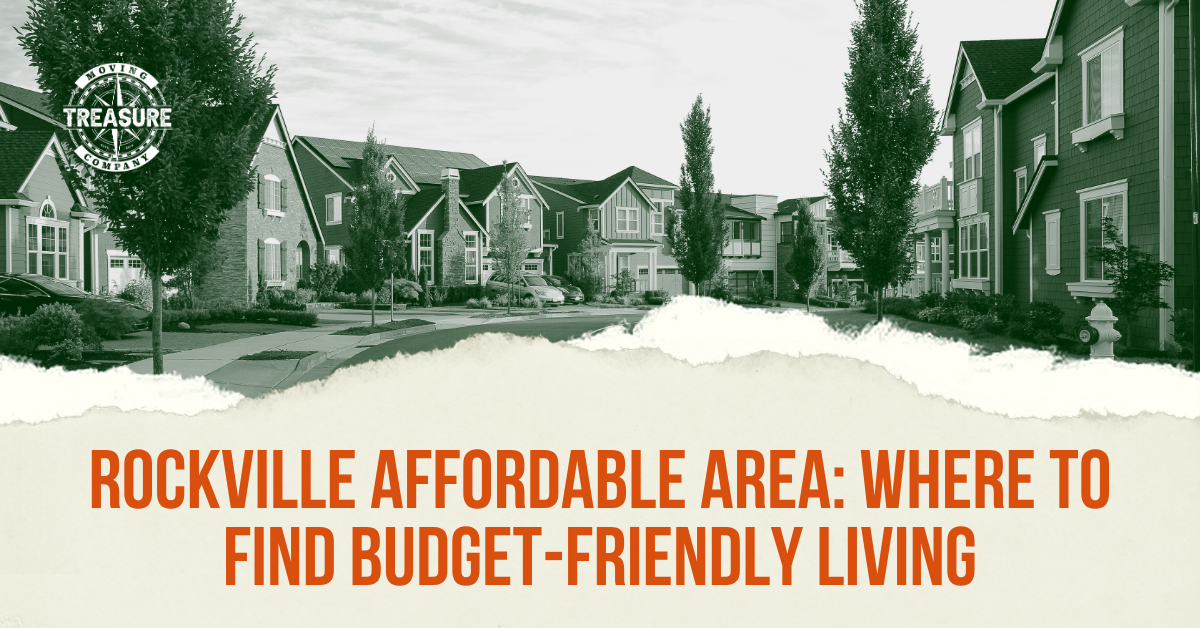
Finding an affordable area in Rockville takes research, but several neighborhoods offer budget-conscious options without sacrificing quality of life. Twinbrook, Derwood/Parkside Estates, and apartment communities near Shady Grove provide the most cost-effective living in the city. These areas deliver good value despite Rockville's overall higher cost of living compared to national averages.
Housing costs dominate most household budgets. Rockville's proximity to Washington, D.C. pushes prices higher than many Maryland communities. But smart neighborhood selection can save thousands annually. Some areas offer homes around $500,000 while others feature apartments priced below metropolitan averages.
Understanding Rockville's Cost of Living Reality
Is it expensive to live in Rockville, MD? The honest answer is yes compared to most American cities. The city sits in Montgomery County, one of Maryland's priciest areas. Housing, transportation, and general expenses all run higher than national medians. But context matters when evaluating affordability.
Location drives much of the cost. Rockville sits just miles from the nation's capital. This proximity provides access to high-paying jobs and cultural amenities. The Metro system connects residents directly to downtown Washington. These benefits come with elevated housing prices.
Several factors influence local costs beyond just location. The school system ranks among Maryland's best, attracting families willing to pay more. Parks and recreation facilities receive strong funding. Public services maintain high standards. These quality-of-life features justify higher costs for many residents.
Income levels in Rockville exceed national averages significantly. Many residents work in government, technology, or healthcare fields. Higher salaries offset some housing expense burden. But not everyone earns these premium wages, making affordable options essential.
How Costs Break Down
Housing consumes the largest portion of most budgets. Median home prices hover around $600,000 across the city. Rental costs vary widely by neighborhood and property type. One-bedroom apartments average $1,800 to $2,500 monthly in most areas.
Transportation adds another significant expense. Gas prices in Maryland run higher than many states. Parking fees apply in commercial districts. But Metro access reduces car dependency for some residents. This can offset transportation costs if you live near a station.
Groceries and dining cost more than national averages but less than downtown Washington. Local farmers markets offer competitive produce prices. Chain grocery stores provide options at various price points. Dining out ranges from affordable ethnic restaurants to expensive fine dining.
Utilities stay moderate compared to housing costs. Electric bills average $120 to $180 monthly for typical apartments. Water and sewage add another $50 to $80. Internet and cable packages run $80 to $150 depending on service levels. These costs don't vary dramatically between neighborhoods. For complete details about living expenses, check this comprehensive Rockville ity guide.
Top Rockville Affordable Area Options for Budget Seekers
Several neighborhoods stand out for providing value within this expensive city. Each affordable area in Rockville offers different benefits and trade-offs. Understanding these differences helps match your budget with your lifestyle needs.
Most Budget-Friendly Neighborhoods
- Twinbrook: This neighborhood claims the title of cheapest area in Rockville. Home prices average around $500,000, significantly below city medians. Rental options also cost less than most Rockville areas. The Twinbrook Metro station provides direct access to downtown Washington without car ownership. Parts of Rock Creek Park fall within this neighborhood, offering free recreation. Housing variety ranges from older single-family homes to modern apartments
- Derwood/Parkside Estates: This peaceful community offers family-friendly living at reasonable prices. Clean streets and safe neighborhoods don't require premium costs here. Strong community spirit creates value beyond just housing expenses. Families find this area particularly budget-friendly while maintaining quality schools and parks. The location provides good access to major roadways without the noise
- Shady Grove Area Apartments: Multiple apartment communities near Shady Grove Metro offer competitive pricing. This concentration of rental options creates market competition that benefits renters. Metro access makes car ownership optional for some residents. Shopping and dining options sit within walking distance of many complexes. These communities typically include amenities like pools and fitness centers
Specific Apartment Communities Worth Considering
Affordable apartments in Rockville MD concentrate in certain areas. The Shady Grove corridor hosts several budget-conscious options. These complexes provide modern amenities without downtown price tags.
Axis at Shady Grove offers contemporary apartments at moderate prices. Units feature updated appliances and finishes. The location near Shady Grove Metro reduces transportation costs. On-site amenities include fitness facilities and community spaces. Management maintains properties well without charging luxury premiums.
The Flats at Shady Grove provides another solid budget option. Floor plans range from studios to two-bedrooms. Prices typically run below area averages for comparable units. Pet-friendly policies accommodate animal owners without excessive fees. Parking gets included in most rental agreements.
The Daley at Shady Grove combines affordability with modern design. Units feature open layouts and contemporary finishes. Community amenities rival more expensive complexes. Location near shopping and Metro adds practical value. Lease terms offer flexibility for different situations.
Camden Shady Grove brings a national management company's resources to the area. Apartments include updated kitchens and in-unit laundry. Community spaces encourage resident interaction. Pricing stays competitive with other Shady Grove options. Professional management responds quickly to maintenance issues.
Rollins Park Apartments sits in a convenient neighborhood with below-average pricing. The location provides easy access to major roads and shopping. Units may feature older finishes but maintain good condition. Lower rent leaves budget room for other expenses. The community attracts diverse residents seeking value.
Hillside Senior Apartment Homes serves residents 62 and older affordably. This specialized community offers age-appropriate amenities and services. Pricing acknowledges senior budget constraints and fixed incomes. Social activities help residents build community connections. The location provides access to healthcare and shopping.
Affordable Areas Near Rockville MD Worth Exploring
Looking at affordable areas near Rockville MD expands your options significantly. Surrounding communities offer lower costs while maintaining reasonable commute access. These areas deserve consideration if Rockville prices stretch your budget too thin.
Nearby Budget-Friendly Communities
Silver Spring sits just south of Rockville with notably lower housing costs. The downtown area offers urban amenities and Metro access. Neighborhoods vary widely in character and price. Some sections provide significantly cheaper options than any Rockville neighborhood. The trade-off involves slightly higher crime rates in some areas.
Germantown offers suburban living at reduced prices. This planned community features good schools and parks. Housing costs run well below Rockville averages. The commute to Washington takes longer without direct Metro access. But for families prioritizing space and affordability, this works well.
Gaithersburg provides middle ground between Rockville prices and more distant suburbs. The city offers its own employment centers, reducing commute needs. Shopping and dining options serve most daily needs locally. Housing costs several areas significantly below Rockville while maintaining similar amenities.
Wheaton delivers urban density at lower costs than Rockville. Metro access connects residents to downtown Washington efficiently. The area features diverse dining and shopping options. Some neighborhoods show age but offer solid value. Schools perform adequately though not at Rockville levels.
Making the Commute Trade-Off
Moving outside Rockville saves money on housing but adds transportation costs and time. Calculate the full impact before deciding. Gas, tolls, and vehicle wear add up quickly. Time spent commuting has value too, whether for work or family.
Metro access changes this equation significantly. Living near a station outside Rockville can cost less than driving from within the city. Monthly Metro passes run around $250 for unlimited rides. Compare this against car ownership costs including insurance, maintenance, and parking.
Employer location matters enormously for commute planning. Jobs in downtown Washington favor Metro-accessible housing anywhere. Positions in Rockville or Bethesda make living in Germantown less practical. Calculate realistic door-to-door times including parking and walking.
Strategies for Affordable Living in Rockville
Beyond choosing the right affordable area in Rockville, several strategies stretch your budget further. Small changes in housing choices and lifestyle create significant savings over time.
Housing Selection Tips
Size matters more than most people realize. A smaller apartment in a good location often beats a larger unit farther out. Consider your actual space needs honestly. Extra bedrooms cost money monthly whether you use them or not.
Older buildings typically cost less than new construction. Units may lack granite counters and stainless appliances. But solid bones and good maintenance matter more than trendy finishes. Older complexes often sit in established neighborhoods with mature trees and character.
Roommate situations cut costs dramatically for single people. Sharing a two-bedroom apartment costs each person far less than separate studios. Choose roommates carefully to avoid conflicts. But this approach makes expensive areas accessible to moderate incomes.
Lease timing affects pricing significantly. Complexes offer best deals during slow leasing periods. Winter months typically see more flexibility and incentives. Moving in January or February can save hundreds compared to peak summer season. This neighborhoods guide helps identify areas worth targeting.
Reducing Transportation Costs
Metro access saves thousands annually compared to car ownership. Monthly unlimited passes cost less than car insurance alone. Eliminate car payments, gas, maintenance, and parking fees. Not everyone can go car-free, but reducing vehicle dependency helps budgets.
Biking infrastructure in Rockville continues improving. Protected bike lanes connect neighborhoods to Metro stations and shopping. A decent commuter bike costs $500 to $1,000 once. Compare this to monthly car expenses. E-bikes extend practical biking range for longer trips.
Walking becomes viable in certain neighborhoods. Twinbrook and areas near Shady Grove Metro allow car-free errands. Grocery stores, pharmacies, and restaurants sit within walking distance. This lifestyle reduces transportation costs to nearly nothing.
Carpooling works well for certain commute patterns. Many employers facilitate carpool matching programs. Sharing rides three days weekly cuts driving costs substantially. The social aspect makes commutes more pleasant too.
Family Considerations for Affordable Areas
Families face unique budget challenges when seeking affordable housing. School quality cannot be compromised easily. Safe neighborhoods matter more with children. Space needs increase with each child. These factors complicate the search for budget-friendly options.
Twinbrook and Derwood both serve families well at lower costs. Schools in these areas maintain good performance levels. Parks and recreation programs provide free or low-cost activities. Community connections help families build support networks. For detailed family-focused information, explore this guide to best family neighborhoods in Rockville.
After-school care costs add substantially to family budgets. Some neighborhoods offer more affordable options through community centers. Public programs cost less than private care in many cases. Factor these ongoing expenses into housing decisions.
Activities and sports programs vary in cost by area. Some communities subsidize youth programs through tax support. Others rely entirely on private organizations with higher fees. Research these costs before committing to a neighborhood.
Sources for Affordability Information
Multiple resources track affordable apartments in Rockville MD and neighborhood costs. Understanding these sources helps evaluate information reliability and relevance.
Nextdoor provides resident perspectives on neighborhood affordability and value. Reviews come from people actually living in areas. Cost discussions happen regularly in community forums. This grassroots information captures real experiences beyond statistics.
Real estate reports from local agencies track pricing trends systematically. These documents show median prices, rental rates, and market movements. Data gets updated quarterly or monthly depending on the source. Professional analysis helps interpret raw numbers.
Publications like LivingInMaryland.com compile affordability rankings and guides. Articles compare neighborhoods across multiple factors including cost. These resources aggregate information from various sources. Reading multiple publications provides balanced perspectives.
Apartment listing sites show current market prices in real time. Zillow, Apartments.com, and similar platforms display available units. Filter searches by price, location, and amenities. This research reveals actual market conditions rather than outdated averages.
Making Your Affordable Housing Decision
The best affordable area in Rockville for you depends on your specific situation. Income level, family size, commute needs, and lifestyle preferences all factor in. No single neighborhood works for everyone's budget and requirements.
Visit neighborhoods at different times before deciding. Morning rush hour reveals traffic patterns and commute realities. Afternoon visits show how families use parks and sidewalks. Weekend exploration captures community character. These observations verify what online research suggests.
Calculate total housing costs including utilities and parking. Rent or mortgage represents only part of the expense. Factor in transportation costs based on actual commute distance. Add typical utility bills for unit size and building age. This complete picture shows real affordability.
Consider future income changes in your planning. Job promotions or career changes may increase earnings. Children growing up eventually leave home, reducing space needs. But unexpected income drops can happen too. Choose housing that works if circumstances change.
Rockville's higher costs bring real benefits worth considering. Excellent schools provide children with strong educational foundations. Safe neighborhoods reduce stress and security concerns. Proximity to Washington opens career opportunities. These factors create value that raw cost comparisons miss. Balance budget constraints against quality-of-life gains when making your final decision.

